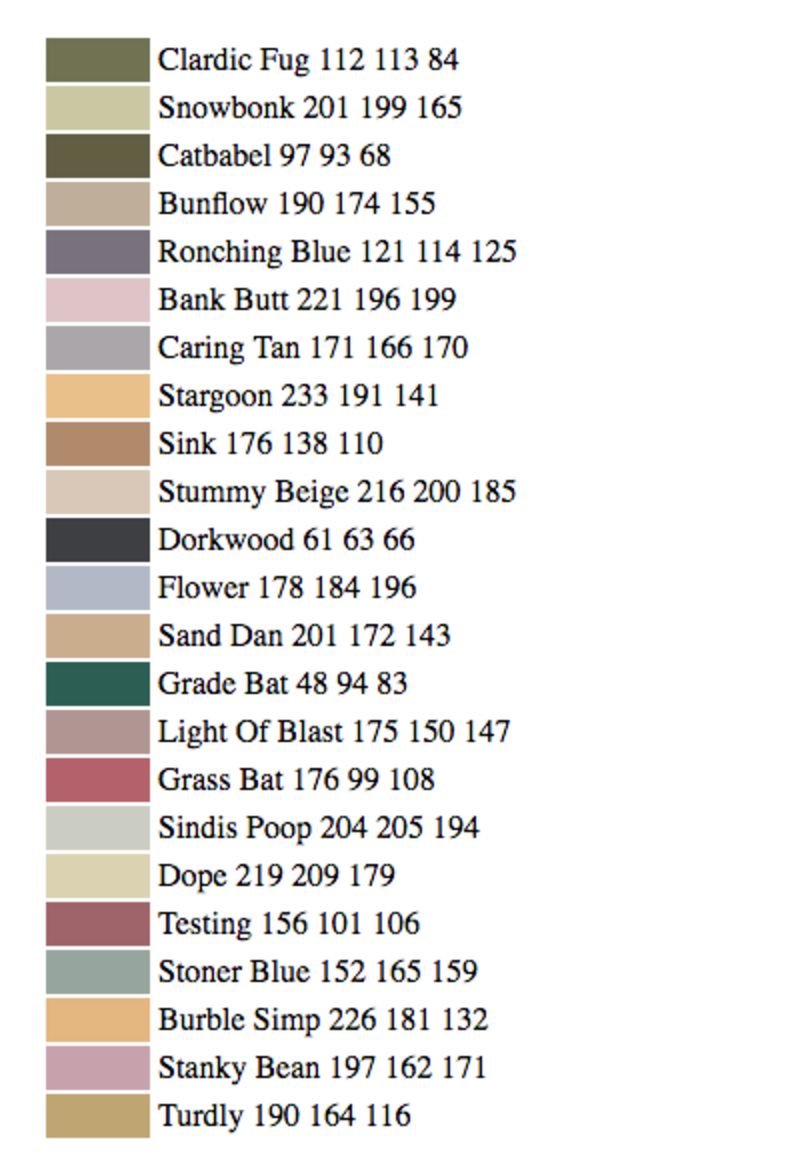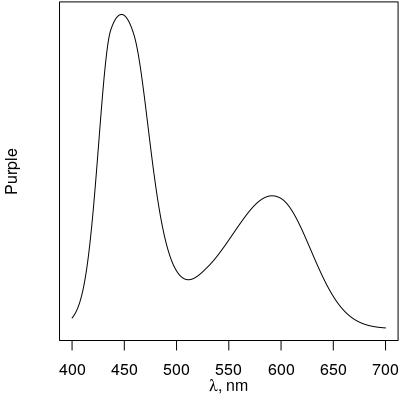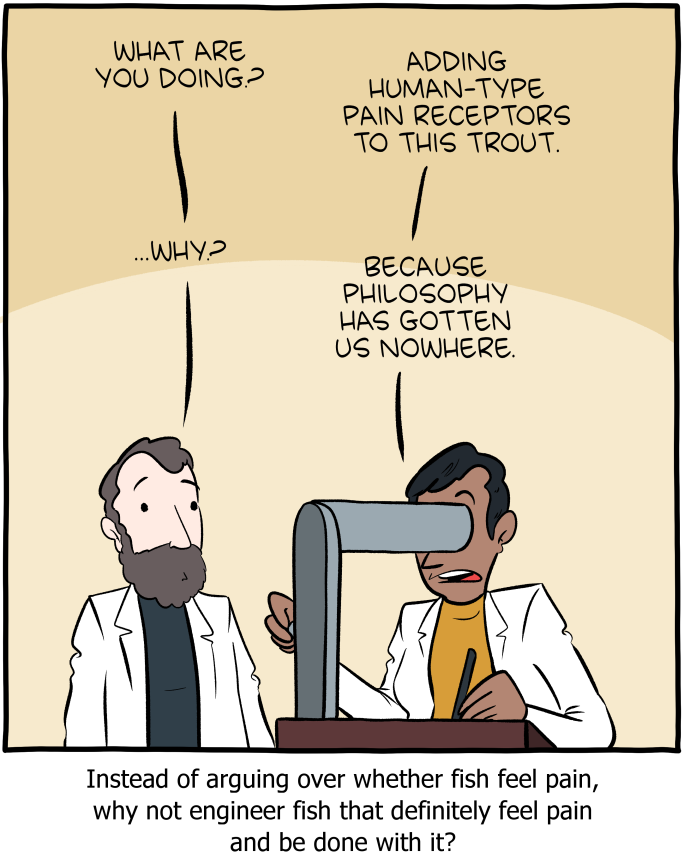Unreal claims concerning purple
-
So, I was subjected to this again yesterday. With a good ol’ “did you know” factoid¹-style prelude. But this time I can present to you dazzling justification for such wisdom, because for once the immediate response was something other than “I already ‘know’ that.”
You see, purple is a mixture of red and blue. Which means that when you see that red and blue together, you would be perceive a different colour that already exists (you know… like any other mixture of colours…), so while being unable to distinguish between the red-blue mixture and the pre-existing colour, your brain is able to tell the difference for long enough to invent a brand-new colour – purple.
The speaker then confessed they didn’t fully understand either. But that was attributed to a foggy memory, rather than anything to do with a house of cards that contradicts reality.
¹ factoid, n. From fact + -oid: resembling a fact at only the surface level.
Apparently this was the original meaning in 1973, something that only gains truth by how often it’s stated, but the word acquired its modern meaning of “trivial fact” around 1990-ish in the USA.So with either usage, you could say an example of a factoid is that factoid means “trivial fact.”
addendum: I think this explanation stems from the “average wavelength” theory of colour mixtures. The idea goes that red is a bunch of red frequencies and green is a bunch of green frequencies, so red + green makes the intermediate frequencies – yellow.
Obviously, red + blue doesn’t produce green. So rather than dismissing the hypothesis as obviously unworkable, you just declare purple to be fake instead. Easy!
Since white is also not green, I guess it’s fake too?
-
@Karla said in Unreal claims concerning purple:
@robo2 said in Unreal claims concerning purple:
@kazitor not sure which subcultures you are in, but I never heard about this particular idea before. Sounds stupid though.
On the other hand, I have heard people say that about pink.Pink is really just light red. We don't have a special color for light blue or light yellow.

-
@kazitor said in Unreal claims concerning purple:
purple is a mixture of red and blue
It's a particular pattern of activation of colour receptors. Those receptors have ranges of activity. It turns out that there's no single wavelength that produces that pattern of activity; purple is therefore necessarily a mix of “pure” colours.
-
-
@boomzilla said in Unreal claims concerning purple:
Who needs color names when you can just refer to/remember colors by their RGB triplets?

-
@El_Heffe said in Unreal claims concerning purple:
@Karla said in Unreal claims concerning purple:
@robo2 said in Unreal claims concerning purple:
@kazitor not sure which subcultures you are in, but I never heard about this particular idea before. Sounds stupid though.
On the other hand, I have heard people say that about pink.Pink is really just light red. We don't have a special color for light blue or light yellow.

How many of those did you know?
Exactly.
I'm pretty sure few if any are used in any other context.
-
-
I have not read the attached, so place your bets, unless you've read the attached.
Somehow this seemed like the most appropriate thread.
-
@kazitor said in Unreal claims concerning purple:
I’ve encountered a lot of crap recently about how “purple isn’t real” or “purple is an illusion” or “you can’t actually see purple.” I was aware of this, uh, “subculture” before, but it’s only in the past few months or so that I’ve somewhat-regularly seen this idea supported in my own life. Anyone else experienced something similar?
It’s so suddenly pervasive, in fact, that I’m fully expecting someone here to pipe up in support… let’s start with an explanation of how purple is any different from, say, orange or grey, and go from there.
On an entirely unrelated note, here’s an empirical approximation of the appearance of 420 nm light.

I see nothing but a sucking wound in reality.
-
@aitap said in Unreal claims concerning purple:
@Flips Purple is defined as RGB
#800080, which isXYZ(29.6438, 14.242, 48.47805). Taking into account the XYZ colour matching functions, one of the possible purples could look like this:
It is indistinguishable for humans from any other power distribution spectrum that gives the same values for
∫P(λ)x(λ)dλ,∫P(λ)y(λ)dλ,∫P(λ)z(λ)dλ.False, fails to account for polarity.
-
@kazitor i think smartereveryday youtube channel has a video explaining in detail what's meant by that claim
-
Somebody upvoted my posts in the argument about 1-to-1 color-to-RGB mapping and that made me remember one more fact that shows how ridiculous that idea is.
ORANGE AND BROWN HAVE THE SAME WAVELENGTHS. WHERE IS YOUR GOD NOW @KAZITOR?
-
@kazitor said in Unreal claims concerning purple:
¹ factoid, n. From fact + -oid: resembling a fact at only the surface level.
Apparently this was the original meaning in 1973, something that only gains truth by how often it’s stated, but the word acquired its modern meaning of “trivial fact” around 1990-ish in the USA.So with either usage, you could say an example of a factoid is that factoid means “trivial fact.”
thread.necroed == true, therefore I'll comment here. Every time I hear people talk about factoids, I treat them as if the original meaning is the one and only meaning the word has ever had.
-
@Gąska said in Unreal claims concerning purple:
ORANGE AND BROWN HAVE THE SAME WAVELENGTHS.
No shit?
If you have a point, please do tell.
-
@Gąska said in Unreal claims concerning purple:
ORANGE AND BROWN HAVE THE SAME WAVELENGTHS
If you play a note at that wavelength does anything happen?
-
@hungrier said in Unreal claims concerning purple:
@Gąska said in Unreal claims concerning purple:
ORANGE AND BROWN HAVE THE SAME WAVELENGTHS
If you play a note at that wavelength does anything happen?
Obviously. But you can see how it turned out, and therefore why I'm never doing it again.
-
@kazitor said in Unreal claims concerning purple:
@Gąska said in Unreal claims concerning purple:
ORANGE AND BROWN HAVE THE SAME WAVELENGTHS.
No shit?
If you have a point, please do tell.
1 to 1 mapping cannot exist.
-
@Gąska said in Unreal claims concerning purple:
1 to 1 mapping cannot exist.
Didn't we already conclude that like 5 months ago?
-
@cvi define "we". Because none of the people who initially disagreed have said they changed their mind.
-
@Gąska Discussion drifted away from it, so I guessed that people were either accepting that (or rather, correctly concluding that it was largely meaningless question anyway), uninterested in the that particular detail, or unlikely to change their mind (and thus unlikely to be swayed by random links to ever-reliable sources on the interwebs, include random youtube videos).
have said they changed their mind.
YMBNH.
-
@cvi said in Unreal claims concerning purple:
it was largely meaningless question anyway
I mean, it's WTDWTF.
-
@Gąska said in Unreal claims concerning purple:
I mean, it's WTDWTF.
Meaningless != uninteresting. But, yes.
-
-
So no guesses as to the hot hotness in financial programming? Thank god.
-
The word "color" has so much history, most of which is from before vision was understood, that it's meaningless to be pedantic about it.
I used to have a 2001 Dodge Ram truck. It was painted Poppy Red. In sunlight, it resembled fire engine red, but under sodium lights, it looked like dried mud.
So, we could pretend that when we are talking about color, we are talking about the light that the observer experiences. In this case, speaking of wavelengths makes sense. But, if we stick with this, then my truck changed color - and everything is black in the dark.
If you talk to the designers at Dodge, they might have told you that the paint was Poppy Red in color. But if color describes how something is experienced, then color is a term that does not describe the way a material interacts with light, and therefore a material doesn't even have an innate color. This is going to piss off the entire paint industry.
If color is the way that light is internally experienced in the mind of an observer, then all talk of anything more concrete than philosophy doesn't apply to color.
Unfortunately, color means all of the above. It also probably means a few more things that haven't even come up in this thread. So, purple is both "real" and "fake" because there are so many ways to interpret the statement "Let go, it's turning purple!".
-
@hungrier said in Unreal claims concerning purple:
@Gąska said in Unreal claims concerning purple:
ORANGE AND BROWN HAVE THE SAME WAVELENGTHS
If you play a note at that wavelength does anything happen?
-
@Jaime said in Unreal claims concerning purple:
are so many ways to interpret the statement "Let go, it's turning purple!".
-
@Jaime said in Unreal claims concerning purple:
If color is the way that light is internally experienced in the mind of an observer, then all talk of anything more concrete than philosophy doesn't apply to color.
That's the paradox of psychology. Since there's no way to enter another person's brain, it's impossible to ever know what they actually experience. And yet you can trivially diagnose color blindness by showing one picture and asking one question, with near-perfect accuracy.
Color perception is much more than just philosophy.
-
@Gąska said in Unreal claims concerning purple:
Since there's no way to enter another person's brain
You're wrong, but it's disgusting and usually fatal if you're not a trained neurosurgeon.
-
@dkf at least there would be no question what the person perceives afterwards.
inb4 religious people correct me on this too
-
@Gąska said in Unreal claims concerning purple:
Color perception is much more than just philosophy
Yes. And that's because the idea of color is a crapton of things, not just one of them... like I said in my post.
Also, your example is simply another falsification of the statement "If color is the way that light is internally experienced in the mind of an observer, then all talk of anything more concrete than philosophy doesn't apply to color". Since you have just demonstrated that color does have a relation to my first definition, the third can't be an ideal explanation.
Unfortunately, you can poke a hole in any single definition of color. That's my whole point... trying to pin down the word color enough to make purple real or fake would require using "color" in a way not used by anyone on this planet.
-
@Gąska said in Unreal claims concerning purple:
@dkf at least there would be no question what the person perceives afterwards.

Filed under: Googling for this, I found two strips where the same comic made the same joke. Shame, Weinersmith.
-
@Jaime It's very simple:
- There's the spectral properties of a particular colour in a particular lighting situation. These can be measured with a spectroscope; they're resolutely an objective thing.
- There's the activation level of relevant coloured-light-detecting cells in your eye, which is also objective yet very personal. There's some complexity with feedback here because the intensity of light detected will depend on where on the retina it falls, the diameter of the hole in the iris, etc.
- There's the higher-level meaning attached by your brain, which is extremely personal and might as well be entirely subjective. This will include things like “oh, that reminds me of that time in school when…” and other things like that. This is the main level at which subjectivity applies.
The RGB gamut simulates most of a rainbow because it can stimulate the cells (step 2) in a very similar way despite the spectral profile being different (step 1). Whether you perceive it the same is… complicated, as there's a crazy amount of feedback between things in the brain; high-level cognitive processes are not cleanly separated from low-level basic perception.
-
@Jaime said in Unreal claims concerning purple:
@Gąska said in Unreal claims concerning purple:
Color perception is much more than just philosophy
Yes. And that's because the idea of color is a crapton of things, not just one of them... like I said in my post.
No, I don't mean like that at all. I'm not talking about ambiguity, or overlapping meanings, or any of the other confounding factors you mentioned. I'm talking about how, according to our best knowledge, a particular color perception is hard-wired in human DNA itself. But not quite. It differs from culture to culture, apparently - people literally see colors that others don't. But on an individual level, from one person to another within same culture, there's basically no variation at all.
Which has the following consequences:
- The concept of color objectively exists.
- Colors can be objectively classified in terms other than wavelengths.
- Just because something exists solely in people's minds doesn't mean it cannot be objective.
In your statement:
If color is the way that light is internally experienced in the mind of an observer, then all talk of anything more concrete than philosophy doesn't apply to color.
I'm not disagreeing with the prior. I believe the prior is true, but despite the prior being true, the posterior is false because different minds somehow all share the same color perception. Even if colors exist solely in the minds, there's still some objective truth to be talked about them that can be independently confirmed by different observers.
And I find that fascinating, and totally practical.
-
@Gąska said in Unreal claims concerning purple:
I'm talking about how, according to our best knowledge, a particular color perception is hard-wired in human DNA itself. But not quite. It differs from culture to culture, apparently - people literally see colors that others don't. But on an individual level, from one person to another within same culture, there's basically no variation at all.
How the eye works is itself largely universal (excluding people with dichromatism and quadrachromatism; there's not that many of them) but how the brain categorises the information is not. In particular, different cultures place important differences on some distinctions and not others, and the need to recognise or ignore differences in the input results in different connections being built. The hardware of your brain literally reconfigures itself in response to cultural influences.
This applies also to the other senses, especially to your hearing. There are critical differences in pronunciation in some languages that I find intensely difficult to hear at all, and it's entirely due to how by brain discards the information.
OTOH the brain remains able to change. If it becomes truly important to you to learn to distinguish things, you can learn how if you keep trying. (It's hard; giving up stops you from gaining the ability.)
-
@Gąska said in Unreal claims concerning purple:
@Jaime said in Unreal claims concerning purple:
@Gąska said in Unreal claims concerning purple:
Color perception is much more than just philosophy
Yes. And that's because the idea of color is a crapton of things, not just one of them... like I said in my post.
No, I don't mean like that at all. I'm not talking about ambiguity, or overlapping meanings, or any of the other confounding factors you mentioned. I'm talking about how, according to our best knowledge, a particular color perception is hard-wired in human DNA itself. But not quite. It differs from culture to culture, apparently - people literally see colors that others don't. But on an individual level, from one person to another within same culture, there's basically no variation at all.
Which has the following consequences:
- The concept of color objectively exists.
- Colors can be objectively classified in terms other than wavelengths.
- Just because something exists solely in people's minds doesn't mean it cannot be objective.
In your statement:
If color is the way that light is internally experienced in the mind of an observer, then all talk of anything more concrete than philosophy doesn't apply to color.
I'm not disagreeing with the prior. I believe the prior is true, but despite the prior being true, the posterior is false because different minds somehow all share the same color perception. Even if colors exist solely in the minds, there's still some objective truth to be talked about them that can be independently confirmed by different observers.
And I find that fascinating, and totally practical.
I've heard something similar about the spoken word - humans are born with the ability to distinguish a certain number of sounds (about 50, I think). But no language uses all of them, and by age 6 of so children lose the ability to distinguish the 10 or so sounds their language does not use.
-
@PleegWat said in Unreal claims concerning purple:
@Gąska said in Unreal claims concerning purple:
@Jaime said in Unreal claims concerning purple:
@Gąska said in Unreal claims concerning purple:
Color perception is much more than just philosophy
Yes. And that's because the idea of color is a crapton of things, not just one of them... like I said in my post.
No, I don't mean like that at all. I'm not talking about ambiguity, or overlapping meanings, or any of the other confounding factors you mentioned. I'm talking about how, according to our best knowledge, a particular color perception is hard-wired in human DNA itself. But not quite. It differs from culture to culture, apparently - people literally see colors that others don't. But on an individual level, from one person to another within same culture, there's basically no variation at all.
Which has the following consequences:
- The concept of color objectively exists.
- Colors can be objectively classified in terms other than wavelengths.
- Just because something exists solely in people's minds doesn't mean it cannot be objective.
In your statement:
If color is the way that light is internally experienced in the mind of an observer, then all talk of anything more concrete than philosophy doesn't apply to color.
I'm not disagreeing with the prior. I believe the prior is true, but despite the prior being true, the posterior is false because different minds somehow all share the same color perception. Even if colors exist solely in the minds, there's still some objective truth to be talked about them that can be independently confirmed by different observers.
And I find that fascinating, and totally practical.
I've heard something similar about the spoken word - humans are born with the ability to distinguish a certain number of sounds (about 50, I think). But no language uses all of them, and by age 6 of so children lose the ability to distinguish the 10 or so sounds their language does not use.
They do? I think I still have mine. Probably not all of them.
-
@dkf said in Unreal claims concerning purple:
@Gąska said in Unreal claims concerning purple:
I'm talking about how, according to our best knowledge, a particular color perception is hard-wired in human DNA itself. But not quite. It differs from culture to culture, apparently - people literally see colors that others don't. But on an individual level, from one person to another within same culture, there's basically no variation at all.
How the eye works is itself largely universal (excluding people with dichromatism and quadrachromatism; there's not that many of them) but how the brain categorises the information is not. In particular, different cultures place important differences on some distinctions and not others, and the need to recognise or ignore differences in the input results in different connections being built. The hardware of your brain literally reconfigures itself in response to cultural influences.
Which makes it even more fascinating that a black person born and raised in a black district of New York has identical or very nearly identical color perception to someone from a tiny village somewhere in Poland. As you mentioned, there are quite big differences in how people hear words. As far as I know, no such thing exists for vision.
-
@Gąska said in Unreal claims concerning purple:
@dkf said in Unreal claims concerning purple:
@Gąska said in Unreal claims concerning purple:
I'm talking about how, according to our best knowledge, a particular color perception is hard-wired in human DNA itself. But not quite. It differs from culture to culture, apparently - people literally see colors that others don't. But on an individual level, from one person to another within same culture, there's basically no variation at all.
How the eye works is itself largely universal (excluding people with dichromatism and quadrachromatism; there's not that many of them) but how the brain categorises the information is not. In particular, different cultures place important differences on some distinctions and not others, and the need to recognise or ignore differences in the input results in different connections being built. The hardware of your brain literally reconfigures itself in response to cultural influences.
Which makes it even more fascinating that a black person born and raised in a black district of New York has identical or very nearly identical color perception to someone from a tiny village somewhere in Poland. As you mentioned, there are quite big differences in how people hear words. As far as I know, no such thing exists for vision.
There are some heterochromats in both directions but yeah.
-
@dkf said in Unreal claims concerning purple:
Whether you perceive it the same is… complicated
And pretty much impossible to determine, since you can't experience someone else's perception.
You might be able to measure something kind of in-between your levels 2 and 3 by presenting to subject B light of various spectral properties that subject A perceives as the same (or very similar) color, and ask subject B if he/she also perceives them as the same color. (That is, subject A perceives a source of light (reflected or emitted, whatever) having certain intensities at certain wavelengths (call this α) and another source of light having somewhat different intensities (β) as the same color. Show the same light sources α and β to subject B. Does subject B say they are the same or different colors?) If subject B also says they're the same color, you still can't know the subjective part of B's perception, but at least the level 2 response and some part of the level 3 response is essentially similar.
I think.
-
@Gąska said in Unreal claims concerning purple:
Which makes it even more fascinating that a black person born and raised in a black district of New York has identical or very nearly identical color perception to someone from a tiny village somewhere in Poland. As you mentioned, there are quite big differences in how people hear words. As far as I know, no such thing exists for vision.
But would that apply with every pair of cultural locations? The evidence is it doesn't; there are languages that don't have names for special colours. The guy from the Bronx and the guy from the backwoods of Poland may well still watch some of the same films and TV shows. They both speak Indo-European languages. They're not that far apart, culturally, not by comparison with, say, tribesmen from the Kalahari or the mountains of Borneo. It is the act of naming things that marks them out as being worthy of distinction and being named. (Yes, it is a circular definition. Brains are reconfigurable hardware; lots of things with them are self-reinforcing.)
-
@dkf said in Unreal claims concerning purple:
Brains are reconfigurable hardware
TIL that @dkf was FPGA-based. (It doesn't surprises me that much, to be honest.)
-
@dkf said in Unreal claims concerning purple:
@Gąska said in Unreal claims concerning purple:
Which makes it even more fascinating that a black person born and raised in a black district of New York has identical or very nearly identical color perception to someone from a tiny village somewhere in Poland. As you mentioned, there are quite big differences in how people hear words. As far as I know, no such thing exists for vision.
But would that apply with every pair of cultural locations? The evidence is it doesn't; there are languages that don't have names for special colours. The guy from the Bronx and the guy from the backwoods of Poland may well still watch some of the same films and TV shows. They both speak Indo-European languages. They're not that far apart, culturally, not by comparison with, say, tribesmen from the Kalahari or the mountains of Borneo.
What about the interwar generation? The was no TV back then, barely any radios (at least in Poland), and there was much less cultural exchange than in later years (not to mention nowadays). And then there was a massive flux of migrants after WW2. And while the language barrier (and the phoneme hearing differences) was a very real, well documented problem and most migrants never got rid of their accent, I've never heard about anyone having any problem with anything related to vision differences. Which makes it looks color perception is much more universal than sound perception.
And if there were differences in how immigrants see the world (I mean visually), I'd love to hear all about them.
-
-
@Gąska I'm not quite sure what you're trying to getting get. So, from what I've understood, we have "sensor elements" (rods and whatnot) in our eyes that react to certain wavelengths. These are rather similar for all humans (minus the various forms of color blindness). There are some people that can perceive UV - but that's apparently more down to a missing/weakened/damaged lens at the front of the eye than the sensing elements.
These sensing elements translate incoming light into different stimuli. How we interpret these stimuli and what names we give is up to us. And, yeah, that's not necessarily very consistent. E.g., there's the thing with blue vs green in Japanese (see https://www.japantimes.co.jp/life/2013/02/25/language/the-japanese-traffic-light-blues-stop-on-red-go-on-what/ or https://en.wikipedia.org/wiki/Ao_(color)); that's apparently something that pops up in other languages too (https://en.wikipedia.org/wiki/Blue–green_distinction_in_language).
Wikipedia has more on that (https://en.wikipedia.org/wiki/Basic_Color_Terms, https://en.wikipedia.org/wiki/Linguistic_relativity_and_the_color_naming_debate), though I haven't read these, because it's like 3 AM or something stupid over here.
-
@cvi said in Unreal claims concerning purple:
I'm not quite sure what you're trying to getting get.
Why it's so well documented that it's impossible for many people to hear the difference between /ʃ/ and /ɕ/, but there exists no analogous phenomenon in visual world?
-
@Zerosquare said in Unreal claims concerning purple:
@dkf was FPGA-based
While @Tsaukpaetra uses somewhat simpler technology:

-
-
@Gąska Do you prefer "more primitive"? "Obsolete"?
That hardware was from 1955 (before even this
 was born), so "simpler", "more primitive" and "obsolete" all certainly apply.
was born), so "simpler", "more primitive" and "obsolete" all certainly apply.And eBay says the seller was in Phoenix. @Tsaukpaetra lives just outside of Phoenix.
QED
-
@HardwareGeek: I imagined him looking more like this:
 odinsblog
odinsblog
 The coding language used by the most elite developers in finance
The coding language used by the most elite developers in finance

